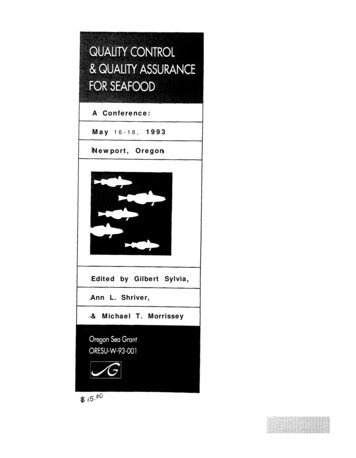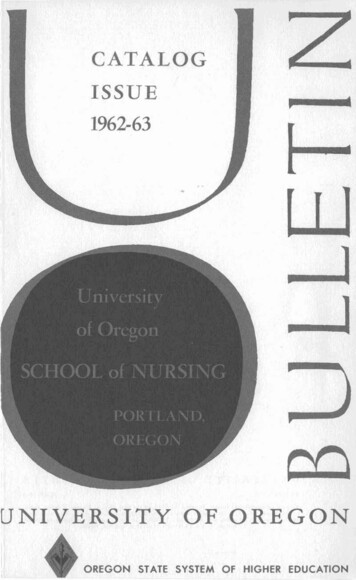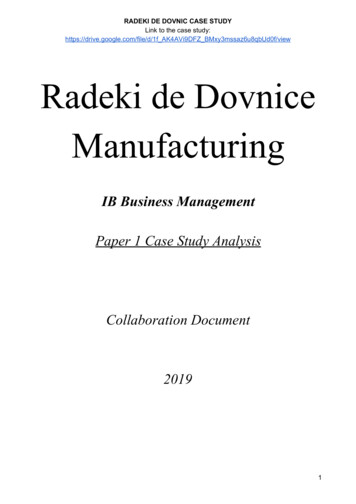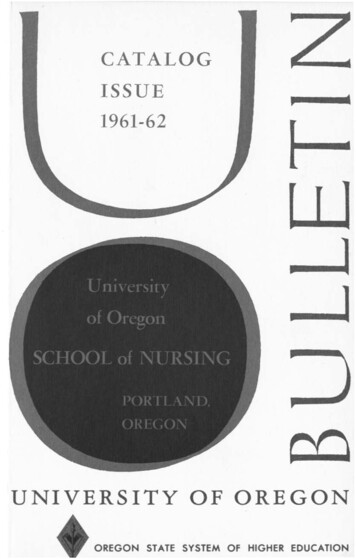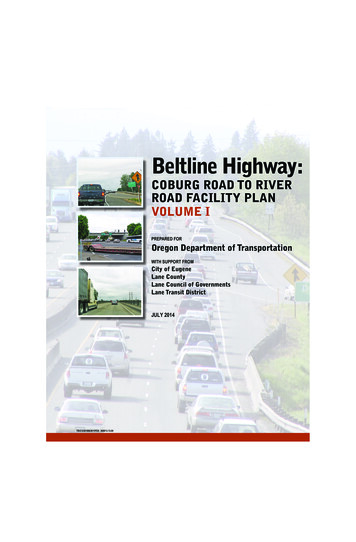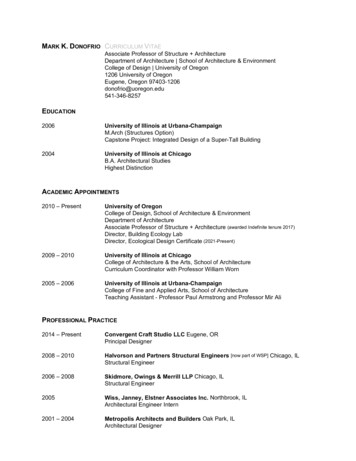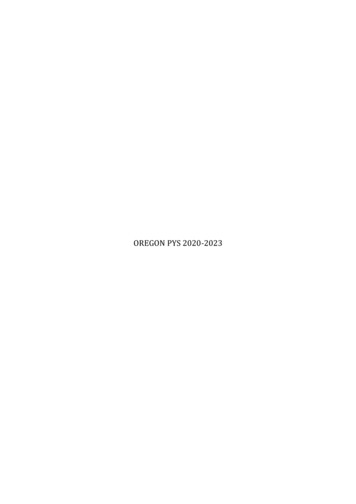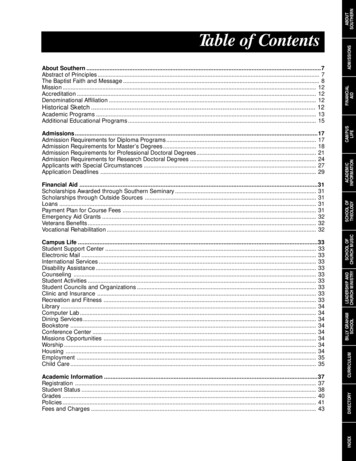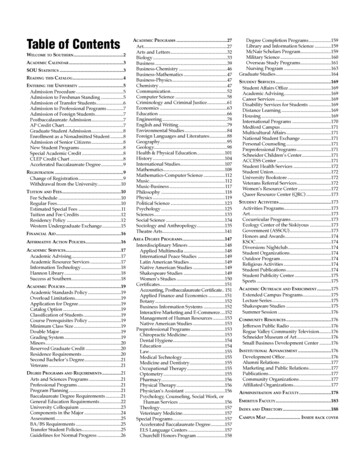
Transcription
1Table of ContentsWELCOME TO SOUTHERN .2ACADEMIC CALENDAR .3SOU STATISTICS .3READING THIS CATALOG .4ENTERING THE UNIVERSITY .5Admission Procedure .5Admission to Freshman Standing .5Admission of Transfer Students .6Admission to Professional Programs .7Admission of Foreign Students.7Postbaccalaureate Admission .7AP Credit Chart .7Graduate Student Admission .8Enrollment as a Nonadmitted Student .8Admission of Senior Citizens .8New Student Programs .8Special Academic Credit .8CLEP Credit Chart .8Accelerated Baccalaureate Degree .9REGISTRATION .9Change of Registration .9Withdrawal from the University.10TUITION AND FEES .10Fee Schedule .10Regular Fees .10Estimated Special Fees .11Tuition and Fee Credits .12Residency Policy .12Western Undergraduate Exchange .15FINANCIAL AID .16AFFIRMATIVE ACTION POLICIES .16ACADEMIC SERVICES.17Academic Advising.17Academic Resource Services .17Information Technology .18Hannon Library .18Success at Southern .18ACADEMIC POLICIES .19Academic Standards Policy .19Overload Limitations.19Application for Degree .19Catalog Option .19Classification of Students .19Course Prerequisites Policy .19Minimum Class Size .19Double Major .19Grading System .19Minors .20Reserved Graduate Credit .20Residence Requirements .20Second Bachelor’s Degree .21Veterans .21DEGREE PROGRAMS AND REQUIREMENTS .21Arts and Sciences Programs .21Professional Programs .21Program Planning .21Baccalaureate Degree Requirements .21General Education Requirements .22University Colloquium .23Components in the Major .24Assessment.25BA/BS Requirements .25Transfer Student Policies .25Guidelines for Normal Progress .26ACADEMIC PROGRAMS .27Art.27Arts and Letters .32Biology .33Business .39Business-Chemistry .46Business-Mathematics .47Business-Physics.47Chemistry .47Communication .52Computer Science .58Criminology and Criminal Justice .61Economics .63Education .66Engineering .78English and Writing .79Environmental Studies .84Foreign Languages and Literatures .88Geography.95Geology.98Health & Physical Education.101History .104International Studies.107Mathematics .108Mathematics-Computer Science .112Music .112Music-Business .117Philosophy .118Physics .119Political Science .123Psychology .125Sciences .133Social Science .134Sociology and Anthropology.135Theatre Arts.141AREA DEGREE PROGRAMS .147Interdisciplinary Minors .148Applied Multimedia .148International Peace Studies .149Latin American Studies .149Native American Studies .149Shakespeare Studies .149Women’s Studies .150Certificates.151Accounting, Postbaccalaureate Certificate. 151Applied Finance and Economics .151Botany .152Business Information Systems .152Interactive Marketing and E-Commerce .152Management of Human Resources .153Native American Studies .153Preprofessional Programs .153Chiropractic Medicine .153Dental Hygiene.154Education .154Law .155Medical Technology .155Medicine and Dentistry .155Occupational Therapy .155Optometry .155Pharmacy .156Physical Therapy .156Physician’s Assistant .156Psychology, Counseling, Social Work, orHuman Services .156Theology .157Veterinary Medicine.157Special Programs .157Accelerated Baccalaureate Degree .157ELS Language Centers .157Churchill Honors Program .158Degree Completion Programs .159Library and Information Science .159McNair Scholars Program.159Military Science .160Overseas Study Programs .161Nursing Program .163Graduate Studies .164STUDENT SERVICES .169Student Affairs Office .169Academic Advising.169Career Services .169Disability Services for Students .169Distance Learning .169Housing .169International Programs .170Medford Campus .171Multicultural Affairs .171National Student Exchange .171Personal Counseling .171Preprofessional Programs .171Schneider Children’s Center.171ACCESS Center .171Student Health Services .172Student Union.172University Bookstore .172Veterans Referral Services .172Women’s Resource Center .172Queer Resource Center (QRC) .173STUDENT ACTIVITIES .173Activities Programs.173Art.173Cocurricular Programs .173Ecology Center of the Siskiyous .173Government (ASSOU) .173Honors and Awards .174KSOC.174Diversions Nightclub.174Student Organizations .174Outdoor Program .174Religious Activities .174Student Publications .174Student Publicity Center .175Sports .175ACADEMIC OUTREACH AND ENRICHMENT .175Extended Campus Programs .175Lecture Series .175Shakespeare Studies .175Summer Session .176COMMUNITY RESOURCES .176Jefferson Public Radio .176Rogue Valley Community Television .176Schneider Museum of Art .176Small Business Development Center .176INSTITUTIONAL ADVANCEMENT .176Development Office .176Alumni Relations .177Marketing and Public Relations .177Publications .177Community Organizations .177Affiliated Organizations.177ADMINISTRATION AND FACULTY .178EMERITUS FACULTY .183INDEX AND DIRECTORY .188CAMPUS MAP . INSIDE BACK COVER
2 Southern Oregon UniversityWelcome to SOUThe UniversitySouthern Oregon University (SOU) is a contemporary public liberal arts and sciences university with selected professional programs at thebachelor’s and master’s levels. It is one of sevenuniversities in the Oregon University System(OUS). Its purpose is to provide intellectual andpersonal growth through quality education.Southern emphasizes critical thinking, careerpreparation, and capacity to live and lead in amulticultural, global society. The University’sstudent-to-faculty ratio of 19:1 is ideal for undergraduate instruction. Classes are taught byfaculty with the highest degrees in their fields(93 percent) in a friendly, service-oriented culture. An Accelerated Baccalaureate Degree Program and other special opportunities and certificates are also available.SOU serves the whole of southern Oregonand the northernmost counties of California.The University is a major partner in the economic, cultural, and environmental developments of this vast area, offering students valuable opportunities to participate. Southern isthe OUS-designated Center of Excellence in theFine and Performing Arts, and it has emergingstrengths in scientific fields and selected professional programs important to the region andstate. SOU’s rising national reputation is basedon its faculty’s notable research and creativetalents, as well as its practical liberal learning.Students get valuable hands-on experiences inresearch and community projects that complement their classroom, laboratory, and studiolearning. Southern is one of twenty institutionsacross the nation selected for membership inthe Council of Public Liberal Arts Colleges (COPLAC). It is engaged internationally througha strong proportion of students from other nations, many exchange programs, and longstanding sister university alliances (the flagship beingthe Universidad de Guanajuato, Mexico).Southern’s main campus in Ashland is largelyresidential in character, whether students liveon campus or in Ashland’s university-friendlyneighborhoods. On-campus housing includesthree complexes with residence halls and superbdining, family housing in Old Mill Village withchildcare service, and a facility for visiting groupsparticipating in Southern’s educational enrichment offerings. SOU serves a growing numberof students who commute from Grants Pass, Oregon, and Redding, California, in addition to providing many educational programs and servicesat the Medford Campus. Southern has fruitful andgrowing partnerships with community colleges,especially Rogue Community College (RCC) andthe College of the Siskiyous, and with such universities as Oregon Health & Science University.The RegionSouthern Oregon University was ranked twentiethin the nation by Outside Magazine (2003) as one ofthe “coolest” places to study, live, and work. Theregion is a uniquely diverse geographic, geological, and ecological area. It is distinguished by theRogue, Umpqua, and Klamath Rivers; Crater LakeNational Park and Shasta National Park; manylakes; and the convergence of three mountainranges: the Cascades, the Siskiyous, and the CoastRange. Such qualities give rise to the University’sdistinctions in environmental studies, as well as itstremendous recreational opportunities, rangingfrom golf, rafting, fishing, and sailing to hiking,skiing, biking, horseback riding, and camping.Art and culture, recreation, tourism, retail sales,natural resources, and the burgeoning healthcareservices are the driving forces of the region’seconomy. Technology industries are diversifying the economy as new companies move intothe area, start-up firms emerge, and technologyadvances locally. There are three medical centersthat offer world-class healthcare services.The region hosts five fairs and thirteen festivals, in addition to nearly thirty art galleries and more than two dozen cultural and artmuseums. The most notable festivals are theOregon Shakespeare Festival (OSF) in Ashlandand the Britt Music Festivals in Jacksonville.Among the theater venues for visiting and local performances is Medford’s Craterian GingerRogers Theater. Recreational facilities include151 public and 110 commercial campgrounds,seventeen golf courses, three racetracks, twoski areas, two ice-skating rinks, and four horsestables. There are sixty-four registered guidedtours in southern Oregon.Ashland and SOUSouthern is located in Ashland at the base of theSiskiyou Mountains in the Rogue Valley. It is afive-hour drive or a one-hour flight from Portland to the north or from San Francisco to thesouth. With a population of 20,000, the charmingtown boasts eighty-five restaurants and ninetythree lodging facilities, sixty-six of which are bedand breakfasts. Its restaurants, delis, bakeries,banks, bookstores, ice-cream parlors, vintagemovie theater, specialty shops, and clothingstores are within easy walking distance of campus. The annual Ashland Independent Film Festival is a popular attraction. A bicycle path leadsfrom SOU to downtown Ashland and beyond.The city offers an ideal setting for picnics andstrolls in its beautiful Lithia Park, with its duckponds, paths, arboretum, and creek.Ashland is surrounded by forests, mountains,lakes, and rivers that provide spectacular areas for outdoor sports and ecological studies.Ashland benefits from a mild four-season climate. The average rainfall is twenty inches, lessthan half that of Portland or Eugene. Althoughthe valley floor is generally free of snow, winter recreational facilities are just a thirty-minutedrive away at Mount Ashland Ski and Snowboard Resort. At 7,500 feet elevation, the resortprovides day and night skiing and has fourchairlifts to twenty-two downhill runs, ranging from beginner to expert. The area has manynearby cross-country ski opportunities in theSiskiyou and Cascade Mountains. Just minutesaway, Emigrant Lake offers waterslides, sailing, and a park. Lake-of-the-Woods, located atthe base of Mount McLaughlin, is less than anhour’s drive from campus.Southern and the community are focal pointsfor rich cultural activities and organizations.Ashland is home for the Oregon ShakespeareFestival, one of the top five regional theatres inthe nation and one of the top three worldwiderotating repertory theatres with Shakespeare attheir core. OSF was created in 1935 by AngusBowmer, a theatre professor at Southern. Thefestival draws more than 380,000 patrons annually. The University’s Schneider Museum of Art(SMA) hosts major art exhibitions and youth programs, and the Center for the Visual Arts (CVA)features artworks by faculty, student, and visiting artists. SOU is home to the Southern OregonSingers, the Rogue Valley Symphony, and theChamber Music Concert Series (CMC). Its MusicDepartment also provides frequent concerts andrecitals by exceptional faculty and students.Ashland CampusSouthern occupies a 175-acre campus withfourteen academic buildings, thirteen residencehalls, family housing, a student union, andmultiuse facilities. All classrooms on campusare accessible to disabled students. Beautifullylandscaped grounds and architecturally pleasing buildings provide a pleasant environmentfor academic endeavors, student club activities,and opportunities to think and study togetherwith peers and faculty. Among the newest facilities are the Computing Services Center(1991), the ACCESS Center for student advisory services (1995), the Schneider Museum ofArt addition (1996), and the Center for the Visual Arts (2000). SOU is nearing completion ofa major renovation and expansion of HannonLibrary. The project will nearly double the sizeof the library and yield a new learning centerwith contemporary services and technologies,ample study spaces, seminar rooms, reading areas with fireplaces, and a coffee shop.Ashland and SOU house many very specialfacilities and services, such as the nation’s onlyFish and Wildlife Forensics Laboratory and thenationally recognized Jefferson Public Radio(JPR). Southern hosts one of the largest NativeAmerican powwows and a popular HawaiianLuau, both of which are coordinated by student multicultural groups. It offers the onlyNative American Studies certificate and minorprograms in Oregon, in addition to providing a popular education program for NativeAmerican youth in the summertime. Among itsextensive array of programs for youth is the Academia Latina program for middle school Hispanic and Latino children. Finally, Southern hasan established reputation for the size and scopeof its extended programs for senior citizens.Medford CampusEstablished in 1984, the Medford Campus provides many of the courses and services available on the main campus in Ashland. The Medford Campus includes degree completion andgraduate programs, classrooms, computer labs,registration, academic advising, a bookstore,and distance-learning capabilities.AccreditationSouthern Oregon University is accredited by theNorthwest Association of Schools and Colleges.The Department of Chemistry programs haveearned approval of the American Chemical Society. The programs of the School of Educationare accredited by the Oregon Teacher Standardsand Practices Commission. The Department ofMusic is an accredited member of the NationalAssociation of Schools of Music.
Academic CalendarAcademic CalendarFall Quarter 2004Fall Faculty Breakfast and Development DayTuesday, September 14New Student Orientation and academicadvising and registrationWednesday–Sunday, September 22–26Residence hall move-in for OrientationWednesday and Thursday, September 22–23Saturday and Sunday, September 25–26All classes beginMonday, September 27Last day to pay fees without penaltyFriday, October 1Last day for new registration, addition of newcourses, or change of sectionFriday, October 1Last day to drop a course without being responsible for a gradeFriday, October 22Veterans Day (classes in session)Thursday, November 11Last day to change P/NP optionFriday, November 12Thanksgiving holidayThursday–Sunday, November 25–November 28Last day to submit course withdrawal form tothe Registrar’s Office; last day to withdrawcompletely from the UniversityMonday, November 29Fall quarter final examinationsMonday–Friday, December 6–10Fall quarter endsFriday, December 10Grades dueTuesday, December 14Winter breakMonday–Sunday, December 13–January 2Winter Quarter 2005Academic advising and registration fornew studentsMonday, January 3All classes beginMonday, January 3Last day to pay fees without penaltyFriday, January 7Last day for new registration, addition ofnew courses, or change of sectionFriday, January 7Martin Luther King Jr. Day holidayMonday, January 17Last day to drop a course without beingresponsible for a gradeFriday, January 28Last day to change P/NP optionFriday, February 18Last day to submit course withdrawal formto the Registrar’s Office; last day to withdrawcompletely from the UniversityMonday, March 7Winter quarter final examinationsMonday–Friday, March 14–18Winter quarter endsFriday, March 18Grades dueMonday, March 21Spring breakMonday–Sunday, March 21–27Spring Quarter 2005Academic advising and registration fornew studentsMonday, March 28All classes beginMonday, March 28Last day to pay fees without penaltyFriday, April 1Last day for new registration, addition ofnew courses, or change of sectionFriday, April 1Last day to drop a course without beingresponsible for a gradeFriday, April 22Last day to change P/NP optionFriday, May 13Memorial Day holidayMonday, May 30Last day to submit course withdrawal formto the Registrar’s Office; last day to withdrawcompletely from the UniversityTuesday, May 31Spring quarter final examinationsMonday–Friday, June 6–10Spring quarter endsFriday, June 10CommencementSaturday, June 11Grades dueTuesday, June 14Summer Session 2005Pre-SessionMonday–Friday, June 13–17Registration continues for all sessions; classesbegin; last day to pay fees for first four-weekand eight-week sessions without penaltyMonday, June 20Last day for new registration, addition ofnew courses, or change of sectionFriday, June 24Fourth of July holidayMonday, July 4End of first four-week sessionFriday, July 15Last day to drop a course without beingresponsible for a gradeFriday, July 15Last day to change P/NP option foreight-week sessionFriday, July 22End of eight-week session and secondfour-week sessionFriday, August 12Post-session beginsMonday, August 15SOU StatisticsSTUDENT PROFILETotal enrollment5,506Full-time students4,078Part-time students1,428Undergraduate students4,964Graduate studentsBetween 17 and 25 years oldAverage ageAverage SAT score54273%251,036Average high school GPA3.20Students from Oregon78%Ethnic minoritiesInternational students577 (10.5%)150from 30 countriesMen43%Women57%UNIVERSITY PROFILEAverage class sizeStudent-to-faculty ratioSchools2519:15Departments23Baccalaureate degree programs35Degrees conferred in 2001–20021,204Bachelor’s degrees742Master’s degrees254Certificates208Campus size175 acresAcademic buildings14Classroom space140,855 sq. ft.Housing capacity1,100Family housing206 unitsFinancial aid (annually) 35,283,545Financial aid recipients3,653 students3
4 Southern Oregon UniversityReading thisCatalogCatalog ContentThe content of this catalog is subject to changewithout notice and does not constitute a contract between Southern Oregon University andits students or applicants for admission. Thiscatalog is for information purposes only. Everyeffort is made to ensure the accuracy of the information published, but circumstances changefrequently at an educational institution andnew decisions may affect the accuracy of thisinformation.TerminologyCourse. A subject or instructional subdivisionof a subject offered during a single term.Corequisite. Indicates a course that must be taken simultaneously with the course described.Credit. One unit of credit represents approximately three hours of time each week for oneterm. This time may comprise work in theclassroom, the laboratory, or outside.Curriculum. An organized program of studyproviding integrated cultural or professionaleducation.Discipline. A branch of learning or field ofstudy (e.g., biology, English, or psychology).Elective. An optional rather than a requiredcourse.Grade Point Average (GPA). Grade point average is computed by dividing grade pointsearned by the number of credits attempted.Grades of E, I, P, NP, W, WP, WF, and X do notcarry grade points, and credits for these gradesare not calculated in the GPA. The University’sGPA includes only SOU courses. See page 3 formore information.Practicum. A supervised experience, usually offcampus, arranged with the approval of the instructor and conducted under requirements setby the instructor.Prerequisite. Indicates a course that must becompleted prior to the course described; for example, Mth 95 is required before taking Ch 201.See Course Prerequisites Policy on page 30.Reading and Conference. A selection of materials to be read by an individual student anddiscussed in conference with a professor.Residence Credit. Academic work completedwhile a student is formally admitted and officially registered at SOU.Seminar. A small group of advanced studentsstudying a subject with guidance from a professor. Each student conducts original researchand exchanges the results with fellow groupmembers through informal lectures, reports, anddiscussions.Sequence. Closely related courses extendingthrough more than one term.Term. Approximately one-third of the academicyear and one-quarter of the calendar year. Maybe fall, winter, or spring.Reading a Course DescriptionThe following example illustrates the elementsof a typical course listing:TA 442 Theatre Sound Design3 creditsOffers an advanced study of theatre sound,with an emphasis on providing practical experience in designing sound for various production styles. Prerequisite: TA 242.TA: Prefix. An abbreviation representing the department offering the course. See this page for alisting of prefixes.442: Number. Indicates the approximate level ofthe course (see Course Numbering System below).Theatre Sound Design: Title.3 credits: Indicates the number of credits awarded for successful completion of the course.Offers . . . : Description of course content.Prerequisite: TA 242: The required backgroundcourse necessary for admittance to the course.Students who have not completed the statedprerequisites but have equivalent backgroundshould consult the instructor of the course theyare interested in. The instructor has the authorityto waive the prerequisite requirement in such acase. See Course Prerequisites Policy on page 30.Course registration details (including the CourseReference Number (CRN), grading method, timeand location of class meetings, and instructor’sname) are available in the class schedule, whichis available in hard copy and online each term.Course Numbering SystemCourses throughout the Oregon University System follow this basic numbering system:1–99Noncredit courses or credit courses of remedialnature that do not count toward graduation ordegree and are not included in calculating thegrade point average.100–299Lower division courses.300–499Upper division courses. A student must achievesophomore standing before being permitted toenroll in 300-level courses and junior standingbefore being permitted to enroll in 400-level courses. If the instructor of the course is satisfied thata student meets the criteria for a course, thenthe consent of the instructor permits enrollment.This does not supersede specific prerequisites,which may be stated in the course description.400–499Upper division courses primarily for seniors.400–499/500–599Upper division/graduate courses for seniorsand graduate students. Courses listed in thiscatalog with a joint 4xx/5xx number may beoffered during any quarter (see the class schedule) under either of two options:1. For undergraduate students only; listedunder the 4xx number.2. For both graduate and undergraduatestudents; listed under 4xx/5xx. Graduatestudents enroll in
tours in southern Oregon. Ashland and SOU Southern is located in Ashland at the base of the Siskiyou Mountains in the Rogue Valley. It is a five-hour drive or a one-hour flight from Port-land to the north or from San Francisco to the south. With a population of 20,000, the charming town boasts eighty-five restaurants and ninety-

